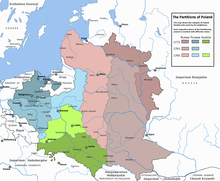Western Krai


Western Krai (Russian: Западный край) is an unofficial name of the westernmost parts of the Russian Empire, excluding the territory of Congress Poland. The term embodies lands annexed by the Russian Empire during subsequent partitions of the Polish–Lithuanian Commonwealth at the end of the 18th century, in 1772, 1793 and 1795. This area is known in Poland as Ziemie Zabrane (Taken Lands, Stolen Lands)[1] but most often they are referred to in Polish historiography and in common talk as part of Zabór Rosyjski (literally Russian Seizure).
Western Krai was made of the following lands of the Polish–Lithuanian Commonwealth:
- from the First Partition of Poland (1772): Inflants (Latgale), northern part of the Polotsk Voivodeship, entire Mstsislaw Voivodeship and Vitebsk Voivodeship, and south eastern part of the Minsk Voivodeship (about 92,000. km²)
- from the Second Partition of Poland (1793): remaining part of the Minsk Voivodeship, the entire Kiev Voivodeship, Bracław Voivodeship and Vilnius Voivodeship, parts of Podole Voivodeship and eastern parts of the Wołyń Voivodeship and Brest Litovsk Voivodeship (about 250,000. km²)
- from the Third Partition of Poland (1795): all the territories east of the Bug River and (about 120,000. km²) (after 1807, the Belostok Oblast)
It has never constituted one official administrative subdivision (Krai) of Russia but was a common name for two such subdivisions: Northwestern Krai and Southwestern Krai.
The territory consisted of nine guberniyas: six Belarusian and Lithuanian ones that constituted the Northwestern Krai (Vilna Governorate, Kovno Governorate, Grodno Governorate, Minsk Governorate, Mogilev Governorate and Vitebsk Governorate) and three Ukrainian ones that constituted the Southwestern Krai (Volhynia Governorate, Podolia Governorate and Kiev Governorate).
Due to its national specifics, the Western Krai had some special laws and elements of government.
During the reign of Alexander I of Russia, Poles prevailed in the western provinces. After 1819, Grodno, Vilnius (rus. Vilna, pol. Wilno), Minsk, Volhynia (pol. Wołyń), Podolia (pol. Podole) governorates and the Belostok Oblast remained under the chief administrative management of the Grand Duke Constantine Pavlovich of Russia. All positions of the local administration were dominated by Poles. Polish–Lithuanian Commonwealth noble families (pol. Szlachta) had there a wide local government and enjoyed many social, economic and military privileges, unlike noble families in so called Congress Poland.[2] This opportunate situation changed dramatically as the November Uprising and later the January Uprising had broken out in 1830[3] and 1863 respectively and both failed in effort to restore an independent state which would have been a kind of successor to the Polish–Lithuanian Commonwealth.[4][5]
With the fall of the Russian Empire and the end of World War I, Western Krai territories became a scene of military and political rivalry between emerging nations of Eastern Europe, the expanding Soviet Union and the Polish state reborn as the Second Polish Republic.[6][7] The Treaty of Riga laid the end to this rivalry in 1921. Although borders were set as a compromise between political stability and national aspirations,[8] none of the sides of the treaty were satisfied. In the new political situation of Europe in the beginning of the 20th century, the Polish–Lithuanian Commonwealth had no chance of being successfully restored. Marshal Józef Piłsudski, however, seeking to revive the cultural and political heritage of the Commonwealth, continued for some time to pursue his (ultimately unsuccessful) plan for the creation of a federation of Central and Eastern European countries, called Intermarium (Międzymorze).
See also
References
- ^ Ilya Prizel, National identity and foreign policy: nationalism and leadership in Poland, Russia and Ukraine. Cambridge University Press 1998, p. 43.
- ^ Wacław Tokarz, Wojna polsko-rosyjska 1830 i 1831, Warszawa 1993, pp 55–57.
- ^ Norman Davies, God's Playground – The History of Poland, The 6th Edition, Kraków 2006, ISBN 978-83-240-0654-0, pp 789–817.
- ^ Norman Davies, God's Playground – The History of Poland, The 6th Edition, Kraków 2006, ISBN 978-83-240-0654-0, Chapter XVI Reveries, pp 819–837.
- ^ Norman Davies, The Europe, Kraków 2008, ISBN 978-83-240-0004-3, pp 879–880.
- ^ Norman Davies, God's Playground – The History of Poland, The 6th Edition, Kraków 2006, ISBN 978-83-240-0654-0, Chapter XiX Independence, pp 862–869.
- ^ Norman Davies, God's Playground – The History of Poland, The 6th Edition, Kraków 2006, ISBN 978-83-240-0654-0, Chapter XXI Borders, pp 963–967.
- ^ Norman Davies, God's Playground – The History of Poland, The 6th Edition, Kraków 2006, ISBN 978-83-240-0654-0, Chapter XXI Borders, p 963.
